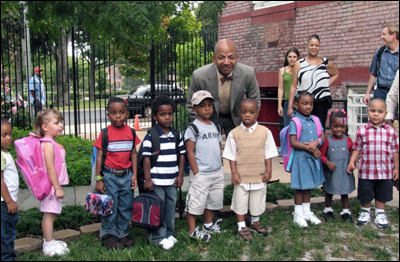Speaking of education
 Mayor Williams visited Peabody Early Childhood Center in Northeast, where he greeted students as they began their first day of school. Peabody is known as the "gateway" to the Capitol Hill Cluster School. Photo from the Mayor's website.
Mayor Williams visited Peabody Early Childhood Center in Northeast, where he greeted students as they began their first day of school. Peabody is known as the "gateway" to the Capitol Hill Cluster School. Photo from the Mayor's website.I am now officially troubled by the charter school movement. At Adams-Morgan Day I listened to the concerns of a District couple, commenting about how their street now is full of young children including their baby of maybe 12 months (I didn't take photos), and how they and their neighbors are likely to leave once their children become of school-age because of the quality of the public schools. The councilmember suggested the charter school option.
What about improving the quality of the local public, truly neighborhood-based schools?
The Capitol Hill Cluster Schools--Peabody, Watkins, and Stuart-Hobson Middle School--are an example of a school improvement initiative that needs to be migrated to other areas of the city. Other such clusters ought to be encouraged and developed throughout the city, to begin the process of school (and neighborhood) stabilization and improvement.
[I keep proposing the idea of an arts-based cluster of schools in my neighborhood--north of the Cluster Schools--to include Wilson, Ludlow-Taylor, Miner, Gibbs, Wheatley, Web, and Maury, as well as junior and senior high schools. Said arts cluster could address performance, visual, English language and writing, foregin language and culture, and media arts. Different schools could specialize in different languages, and there could be artists-in-residence on the various campuses. Other buildings in the broader area could be incorporated into the project. But there hasn't been much traction on this idea.]
Plus, if charter schools are public schools, then the buildings they acquire, in large part using public funds, ought to be owned by the citizens of the District of Columbia.
Anyway, my reservation about charter schools is that they divert innovation resources and community support, and other resources away from neighborhood-based schools. Since schools are often the heart of successful neighborhoods, converting neighborhood schools into city-wide enrollment schools disconnects the school from the surrounding community.
[And note that houses in areas of high-quality schools cost more, because a quality school is a community "amenity" in high demand.]



0 Comments:
Post a Comment
<< Home